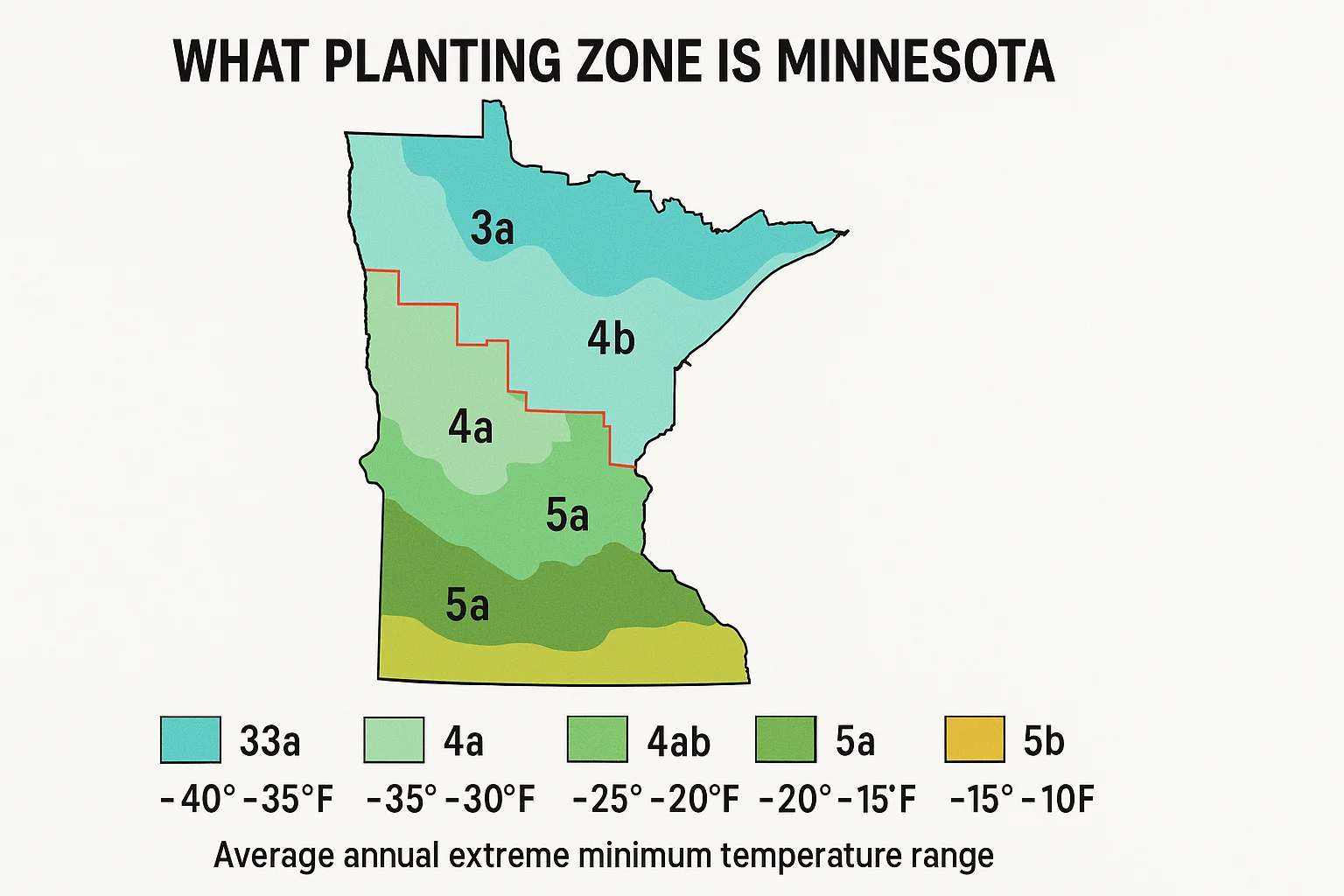What Planting Zone is Minnesota?[Map, Cities, and Growing Tips]

If you’re planning to garden, landscape, or grow perennials in Minnesota, one of the most important things you need to know is: What planting zone is Minnesota? The USDA Plant Hardiness Zones determine which plants will survive your winters and thrive throughout the growing season.
In this guide, we’ll explain what planting zone Minnesota falls into, break it down by region and city, and share essential tips for growing successfully in the Land of 10,000 Lakes.
🌱 What Planting Zone is Minnesota?
Minnesota is known for its cold winters, and the USDA recognizes this by placing the state mostly within Planting Zones 3a to 5b.
| Region | USDA Planting Zone |
|---|---|
| Northern Minnesota | Zone 3a – 3b |
| Central Minnesota | Zone 4a – 4b |
| Southern Minnesota | Zone 5a – 5b |
This means the average annual minimum winter temperatures range from -40°F in the north to -10°F in the south. Understanding what planting zone is Minnesota helps you select plants that can survive these harsh winters.
📍 Minnesota Planting Zones by City
To make it easier, here’s a breakdown of Minnesota planting zones by major cities:
| City | Planting Zone |
|---|---|
| Minneapolis | Zone 4b |
| St. Paul | Zone 4b |
| Rochester | Zone 5a |
| Duluth | Zone 4a |
| Bemidji | Zone 3b |
| Moorhead | Zone 4a |
| Mankato | Zone 4b |
| St. Cloud | Zone 4a |
If you’re asking yourself again, what planting zone is Minnesota, this table gives you a practical answer by location.
🌡️ Why Does the Planting Zone Matter in Minnesota?
Minnesota’s growing conditions are dramatically influenced by its cold winters. Knowing what planting zone is Minnesota ensures you:
- Pick perennials that survive year after year.
- Time your planting to avoid frost damage.
- Choose trees, shrubs, and flowers suited for cold-hardiness.
- Avoid wasting time and money on plants that won’t survive.
For example, a plant rated for Zone 6 or warmer will likely die in a typical Minnesota winter. Conversely, plants suited for Zones 3–5 will thrive if planted at the right time.
🧠 Example: Growing Tomatoes in Zone 4b Minnesota
If you live in Zone 4b Minnesota (like Minneapolis), your last frost date is typically around mid-May. This directly impacts when you can safely plant tomatoes, peppers, or other frost-sensitive crops. Gardeners in warmer zones might plant these in March or April, but in Minnesota, you’ll need to wait until at least mid-May — sometimes even June — for warm-weather crops.
This is exactly why understanding what planting zone is Minnesota is so important for gardeners and homesteaders.
📅 Planting Calendar for Minnesota by Zone
| Crop Type | Zone 3 Start | Zone 4 Start | Zone 5 Start |
|---|---|---|---|
| Cool-season veggies | Late April | Early May | Late March |
| Warm-season crops (tomatoes, peppers) | Early June | Mid-May | Early May |
| Perennials & shrubs | Early Spring | Mid-April | Early April |
Keep in mind, these are general guidelines. Local microclimates and yearly weather variations still apply.
🛠️ Gardening Challenges & Tips for Minnesota’s Zones
Growing in Minnesota means dealing with:
- Shorter growing seasons
- Late frosts in spring
- Early frosts in fall
- Heavy snow cover impacting soil thaw
✅ Tips for Success:
- Start seeds indoors to extend your growing season.
- Use cold frames, row covers, or greenhouses for early planting.
- Choose cold-hardy varieties bred for northern climates.
- Mulch to protect roots from extreme cold.
- Raised beds can help with soil drainage and warming.
🗺️ How to Find Your Exact Planting Zone in Minnesota
While city-wide planting zones are helpful, microclimates can make a difference. To get the most accurate answer to what planting zone is Minnesota in your area, check your zip code on the USDA Plant Hardiness Zone Map.
🧮 Useful Tools for Minnesota Gardeners
Boost your gardening success with these free calculators:
- Soil Volume Calculator – Know exactly how much soil you need for raised beds.
- Plant Spacing Calculator – Prevent overcrowding and maximize yield.
- Indoor Plant Watering Calculator – Perfect for your houseplants or container garden.
🙋 Frequently Asked Questions
What planting zone is Minnesota in?
Minnesota falls within Planting Zones 3a to 5b, depending on location. Northern areas are colder (Zone 3), while southern areas like Rochester are milder (Zone 5).
Can you grow perennials in Minnesota?
Yes, but you must choose cold-hardy perennials suited for your zone. Plants rated for Zones 3–5 are safe choices in Minnesota’s climate.
When is the last frost in Minnesota?
Typically, last frost dates range from mid-May (Zone 4b) to early June (Zone 3a). Always check local forecasts for accuracy.
✅ Final Thoughts: What Planting Zone is Minnesota?
Understanding what planting zone is Minnesota is essential for any successful garden in this northern state. With Zones 3a to 5b covering the region, choosing the right plants and timing is everything.
Plan ahead, select zone-appropriate varieties, and use protective measures to make the most of Minnesota’s challenging but rewarding growing seasons.
Happy gardening, Minnesota!
